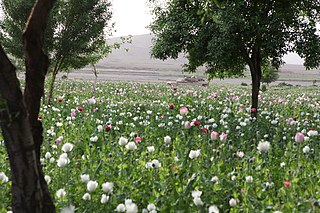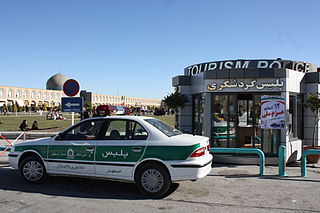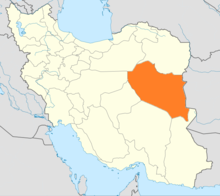
Jundallah, also known as the People's Resistance Movement of Iran (PRMI), was a Sunni Salafi militant organization based in Sistan and Baluchestan, a province in southeast Iran. The group shared its name with another Baloch group active in Pakistani Balochistan as part of the same insurgency, that claims to be fighting for the "equal rights of Sunni Muslims in Iran".

The Taliban insurgency began after the group's fall from power during the 2001 War in Afghanistan. The Taliban forces fought against the Afghan government, led by President Hamid Karzai, and later by President Ashraf Ghani, and against a US-led coalition of forces that has included all members of NATO; the 2021 Taliban offensive resulted in the collapse of the government of Ashraf Ghani. The private sector in Pakistan extends financial aid to the Taliban, contributing to their financial sustenance.

Afghanistan has long had a history of opium poppy cultivation and harvest. As of 2021, Afghanistan's harvest produces more than 90% of illicit heroin globally, and more than 95% of the European supply. More land is used for opium in Afghanistan than is used for coca cultivation in Latin America. The country has been the world's leading illicit drug producer since 2001. In 2007, 93% of the non-pharmaceutical-grade opiates on the world market originated in Afghanistan. By 2019 Afghanistan still produced about 84% of the world market. This amounts to an export value of about US $4 billion, with a quarter being earned by opium farmers and the rest going to district officials, insurgents, warlords, and drug traffickers. In the seven years (1994–2000) prior to a Taliban opium ban, the Afghan farmers' share of gross income from opium was divided among 200,000 families.

The following items form a partial timeline of the War in Afghanistan. For events prior to October 7, 2001, see 2001 in Afghanistan.
Events from the year 2007 in Afghanistan.
Gangs in Canada are mostly present in the major urban areas of Canada, although their activities are not confined to large cities.
This article deals with activities of the U.S. Central Intelligence Agency related to transnational crime, including the illicit drug trade.

An extrajudicial killing is the deliberate killing of a person without the lawful authority granted by a judicial proceeding. It typically refers to government authorities, whether lawfully or unlawfully, targeting specific people for death, which in authoritarian regimes often involves political, trade union, dissident, religious and social figures. The term is typically used in situations that imply the human rights of the victims have been violated; deaths caused by legal police actions or legal warfighting on a battlefield are generally not included, even though military and police forces are often used for killings seen by critics as illegitimate. The label "extrajudicial killing" has also been applied to organized, lethal enforcement of extralegal social norms by non-government actors, including lynchings and honor killings.

Crime in Iran is present in various forms, and may include the following offences: murder, kidnapping, theft, fraud, money laundering, drug trafficking, drug dealing, alcohol smuggling, oil smuggling, tax evasion, terrorism, not wearing "proper" hijab, eating and drinking during Ramadan, drinking alcohol, and many other crimes.
The timeline of some of the most relevant events in the Mexican drug war is set out below. Although violence between drug cartels had been occurring for three decades, the Mexican government held a generally passive stance regarding cartel violence through the 1980s and early 2000s.

Mohammed Daud Daud, also known as General Daud Daud, an ethnic Tajik, was the police chief in northern Afghanistan and the commander of the 303 Pamir Corps. He was an opponent of the Afghan Taliban.

Antonio Ezequiel Cárdenas Guillén, commonly referred to by his alias Tony Tormenta, was a Mexican drug lord and co-leader of the Gulf Cartel, a drug trafficking organization based in Tamaulipas. He headed the criminal group along with Jorge Eduardo Costilla Sánchez. Antonio was considered by Mexican security forces as one of Mexico's most-wanted men.
La Línea is currently the leading faction of the Juárez Cartel originally designed to be one of the cartel's enforcer units set up by a number of former and active-duty policemen, heavily armed and extensively trained in urban warfare. Their corrupt "line" of policemen were set up to protect drug traffickers, but after forming an alliance with Barrio Azteca to fight off the forces of the Sinaloa Cartel in 2008, they established a foothold in Ciudad Juárez as the enforcement wing of the Juárez cartel. La Línea has also been involved in extortions and kidnappings. As of 2021, La Línea has formed an alliance with the Jalisco New Generation Cartel in Ciudad Juárez to fight off influence and incursions from the Sinaloa Cartel.
Gelson Domingos da Silva, a Brazilian camera operator for the Rede Bandeirantes TV network, died while covering a drug bust in Rio de Janeiro as the government of Brazil prepared for its hosting of the 2016 Summer Olympics. Domingos was the first Brazilian journalist to die in this type of crime setting in Brazil.
Gonzalo Inzunza Inzunza, commonly referred to by his alias El Macho Prieto, was a Mexican suspected drug lord and high-ranking leader of the Sinaloa Cartel, a criminal group based in Sinaloa, Mexico. He worked as the cartel's assassins chief under the tutelage of Ismael "El Mayo" Zambada and as the regional leader of the cartel in the states of Baja California and Sonora. His base of operations was in Mexicali, where he coordinated marijuana and cocaine shipments through the Calexico–Mexicali border region. On 18 December 2013, Inzunza was killed in a shootout with Mexican authorities in the resort area of Puerto Peñasco, Sonora. Before the gunfight was over, several of his gunmen took the corpse of the drug lord with them.

Abdul Raziq Achakzai, also known as General Raziq, was the chief of police for Kandahar Province. Many Afghans regarded him as a national hero while others viewed him simply as a warlord. In late 2001, Achakzai became a member of Gul Agha Sherzai's forces whom the Taliban had surrendered to after the U.S. invasion of Afghanistan. Achakzai was considered to be one of the most powerful security officials in Afghanistan for the last few years of his life.

On 23 April 2009, a clash erupted between the border guards of Afghanistan and Iran in Nimroz province near the Afghanistan–Iran border. One Iranian border guard was killed in the clash and another border guard was captured by the Afghan border police. According to General Saifullah Hakim, head of Afghanistan's border police in Nimroz, the cause of the clash was the incursion by the Iranian border guards into the Tang district of Nimroz province. Iran's Press TV also confirmed that a clash took place between the border guards of two countries and one Iranian soldier was killed while another was captured in the clash.
Events in the year 2023 in Iran.










